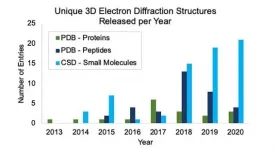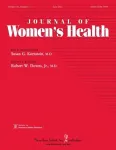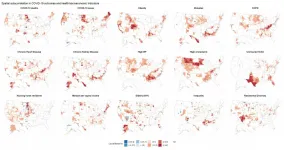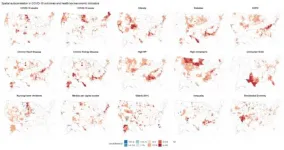(Press-News.org) Magnetars are bizarre objects -- massive, spinning neutron stars with magnetic fields among the most powerful known, capable of shooting off brief bursts of radio waves so bright they're visible across the universe.
A team of astrophysicists has now found another peculiarity of magnetars: They can emit bursts of low energy gamma rays in a pattern never before seen in any other astronomical object.
It's unclear why this should be, but magnetars themselves are poorly understood, with dozens of theories about how they produce radio and gamma ray bursts. The recognition of this unusual pattern of gamma ray activity could help theorists figure out the mechanisms involved.
"Magnetars, which are connected with fast radio bursts and soft gamma repeaters, have something periodic going on, on top of randomness," said astrophysicist Bruce Grossan, an astrophysicist at the University of California, Berkeley's Space Sciences Laboratory (SSL). "This is another mystery on top of the mystery of how the bursts are produced."
The researchers -- Grossan and theoretical physicist and cosmologist Eric Linder from UC Berkeley and postdoctoral fellow Mikhail Denissenya from Nazarbayev University in Kazakhstan -- discovered the pattern in bursts from a soft gamma repeater, SGR1935+2154, that is a magnetar, a prolific source of soft or lower energy gamma ray bursts and the only known source of fast radio bursts within our Milky Way galaxy. They found that the object emits bursts randomly, but only within regular four-month windows of time, each active window separated by three months of inactivity.
On March 19, the team uploaded a preprint claiming "periodic windowed behavior" in soft gamma bursts from SGR1935+2154 and predicted that these bursts would start up again after June 1 -- following a three month hiatus -- and could occur throughout a four-month window ending Oct. 7.
On June 24, three weeks into the window of activity, the first new burst from SGR1935+2154 was observed after the predicted three month gap, and nearly a dozen more bursts have been observed since, including one on July 6, the day the paper was published online in the journal Physical Review D.
"These new bursts within this window means that our prediction is dead on," said Grossan, who studies high energy astronomical transients. "Probably more important is that no bursts were detected between the windows since we first published our preprint."
Linder likens the non-detection of bursts in three-month windows to a key clue -- the "curious incident" that a guard dog did not bark in the nighttime -- that allowed Sherlock Holmes to solve a murder in the short story "The Adventure of Silver Blaze".
"Missing or occasional data is a nightmare for any scientist," noted Denissenya, the first author of the paper and a member of the Energetic Cosmos Laboratory at Nazarbayev University that was founded several years ago by Grossan, Linder and UC Berkeley cosmologist and Nobel laureate George Smoot. "In our case, it was crucial to realize that missing bursts or no bursts at all carry information."
The confirmation of their prediction startled and thrilled the researchers, who think this may be a novel example of a phenomenon -- periodic windowed behavior -- that could characterize emissions from other astronomical objects.
Mining data from 27-year-old satellite
Within the last year, researchers suggested that the emission of fast radio bursts -- which typically last a few thousandths of a second -- from distant galaxies might be clustered in a periodic windowed pattern. But the data were intermittent, and the statistical and computational tools to firmly establish such a claim with sparse data were not well developed.
Grossan convinced Linder to explore whether advanced techniques and tools could be used to demonstrate that periodically windowed -- but random, as well, within an activity window -- behavior was present in the soft gamma ray burst data of the SGR1935+2154 magnetar. The Konus instrument aboard the WIND spacecraft, launched in 1994, has recorded soft gamma ray bursts from that object -- which also exhibits fast radio bursts -- since 2014 and likely never missed a bright one.
Linder, a member of the Supernova Cosmology Project based at Lawrence Berkeley National Laboratory, had used advanced statistical techniques to study the clustering in space of galaxies in the universe, and he and Denissenya adapted these techniques to analyze the clustering of bursts in time. Their analysis, the first to use such techniques for repeated events, showed an unusual windowed periodicity distinct from the very precise repetition produced by bodies rotating or in orbit, which most astronomers think of when they think of periodic behavior.
"So far, we have observed bursts over 10 windowed periods since 2014, and the probability is 3 in 10,000 that while we think it is periodic windowed, it is actually random," he said, meaning there's a 99.97% chance they're right. He noted that a Monte Carlo simulation indicated that the chance they're seeing a pattern that isn't really there is likely well under 1 in a billion.
The recent observation of five bursts within their predicted window, seen by WIND and other spacecraft monitoring gamma ray bursts, adds to their confidence. However, a single future burst observed outside the window would disprove the whole theory, or cause them to redo their analysis completely.
"The most intriguing and fun part for me was to make predictions that could be tested in the sky. We then ran simulations against real and random patterns and found it really did tell us about the bursts," Denissenya said.
As for what causes this pattern, Grossan and Linder can only guess. Soft gamma ray bursts from magnetars are thought to involve starquakes, perhaps triggered by interactions between the neutron star's crust and its intense magnetic field. Magnetars rotate once every few seconds, and if the rotation is accompanied by a precession -- a wobble in the rotation -- that might make the source of burst emission point to Earth only within a certain window. Another possibility, Grossan said, is that a dense, rotating cloud of obscuring material surrounds the magnetar but has a hole that only periodically allows bursts to come out and reach Earth.
"At this stage of our knowledge of these sources, we can't really say which it is," Grossan said. "This is a rich phenomenon that will likely be studied for some time."
Linder agrees and points out that the advances were made by the cross-pollination of techniques from high energy astrophysics observations and theoretical cosmology.
"UC Berkeley is a great place where diverse scientists can come together," he said. "They will continue to watch and learn and even 'listen' with their instruments for more dogs in the night."
INFORMATION:
Bacterial vaginosis is the most common and recurrent gynecological condition affecting nearly 30% of women between the ages of 15 and 44, according to the U.S. Centers for Disease Control and Prevention. A University of Arizona Health Sciences-led study recently identified a specific bacteria family and uncovered how it contributes to bacterial vaginosis, paving the way for new insights into disease prevention and treatment.
Led by Melissa Herbst-Kralovetz, PhD, a member of the BIO5 Institute and associate professor of basic medical sciences at the College of Medicine - Phoenix, researchers found that members of the Veillonellaceae bacteria family contribute to an increase in inflammation and cell death, and alter the acidity of the cervical microenvironment. These changes support bacterial ...
CAMBRIDGE July 13, 2021 - To date, solving structures of potential therapeutics using X-ray diffraction (XRD) has been an assumed, pivotal step in the drug development process. But a recent paper by a team of researchers led by NanoImaging Services shows how microcrystal electron diffraction (MicroED) is growing to obtain the structures of potential pharmaceuticals.
Three-dimensional crystal structures that show the relative positions of atoms, bonds and intramolecular interactions are needed to understand stability, reactivity, solubility and, ultimately, suitability ...
New Rochelle, NY, July 13, 2021--Males with COVID-19 had significantly higher rates of hospitalization and of transfer to the intensive care unit (ICU) according to a new study. A higher percentage of males died of COVID-19 compared to females, as reported in the study published in the peer-reviewed Journal of Women's Health. Click here to read the article now.
Joanne Michelle Gomez, MD, Rush University Medical Center, and coauthors, studied the first 8,108 positive COVID-19 patients that presented to the Rush University System from March 1-June 21, 2020. Nineteen percent of males required hospitalization, compared to 13% of females. ...
In a new study of adults from the general population who were infected with COVID-19 in 2020, more than a quarter report not having fully recovered after six to eight months. Those findings are described this week in the open-access journal PLOS ONE by Milo Puhan and colleagues at the University of Zurich, Switzerland.
While initial public health responses to the SARS-CoV-2 virus focused on reducing the acute burden of COVID-19, a growing body of evidence indicates that the infection can also result in longer-term physical and mental health consequences. These long-term consequences, currently referred to as "post-COVID-19 syndrome" or "Long Covid" are ...
COVID-19 vaccination strategies in the United States are informed by individual characteristics such as age and occupation. A study published in the open access journal PLOS Medicine by Sasikiran Kandula and Jeffrey Shaman of Columbia University, New York, United States suggests that including socioeconomic indicators as prioritization criteria for vaccination may help minimize severe outcomes, particularly deaths.
Efforts to reduce COVID-19 mortality rates in the US have focused on prioritizing vaccination initially for those at a higher risk of severe outcomes. The effectiveness of population-level ...
An estimated 43 percent of the variability in U.S. COVID-19 mortality is linked with county-level socioeconomic indicators and health vulnerabilities, with the strongest association seen in the proportions of people living with chronic kidney disease and living in nursing homes. The study by Columbia University Mailman School of Public Health researchers suggests that allocating vaccines based on these factors could help minimize severe outcomes, particularly deaths. Results are published in the open-access journal PLOS Medicine.
"It is well known that COVID-19 deaths are concentrated in communities with underlying ...
Researchers have conducted a global study on the effectiveness of recently established protected areas in preventing forest loss
The study explores protected area performance by countries, with South Africa, Cambodia, Latvia, Guatemala, Uruguay, Brazil and New Zealand leading the way in the effectiveness of their protected areas
The research team estimated that overall, protected areas established between 2000-2012 prevented 86,062 square kilometers of forest loss
If all countries had protected areas that were as effective as their top-performing neighbor, then an additional 33,020 square kilometers of forests would have been saved
Machine learning found that agricultural ...
The University of Alberta-led research followed more than 400 infants from the CHILD Cohort Study (CHILD) at its Edmonton site. Boys with a gut bacterial composition that was high in the bacteria Bacteroidetes at one year of age were found to have more advanced cognition and language skills one year later. The finding was specific to male children.
"It's well known that female children score higher (at early ages), especially in cognition and language," said Anita Kozyrskyj, a professor of pediatrics at the U of A and principal investigator of the SyMBIOTA (Synergy in Microbiota) laboratory. "But when it comes to gut microbial ...
Children exposed to elevated levels of air pollution may be more likely to have poor inhibitory control during late childhood and poor academic skills in early adolescence, including spelling, reading comprehension, and math skills. Difficulty with inhibition in late childhood was found to be a precursor to later air pollution-related academic problems. Interventions that target inhibitory control might improve outcomes.
Results of the study by researchers at the Columbia Center for Children's Environmental Health (CCCEH) at Columbia University Mailman School of Public Health and Columbia University Irving Medical Center are published in the journal Environmental ...
Compared with heterosexual smokers, menthol cigarette smoking is higher among lesbian, gay and bisexual cigarette smokers, according to a Rutgers-led study, especially among bisexual and lesbian/gay female cigarette smokers.
The study, published in the journal Nicotine & Tobacco Research, examined national data from 2015 to 2019 of individuals ages 18 years and older by sex and sexual identity and found that among smokers, 54 and 50 percent of bisexual and lesbian/gay females smokers preferred menthol cigarettes, respectively, compared with 39 percent of smokers overall.
This study comes in the wake of plans by the U.S. Food and Drug Administration to ban menthol cigarettes; a move that researchers say is ...





